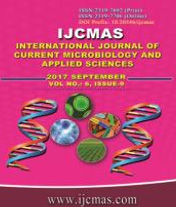


 National Academy of Agricultural Sciences (NAAS)
National Academy of Agricultural Sciences (NAAS)

|
PRINT ISSN : 2319-7692
Online ISSN : 2319-7706 Issues : 12 per year Publisher : Excellent Publishers Email : editorijcmas@gmail.com / submit@ijcmas.com Editor-in-chief: Dr.M.Prakash Index Copernicus ICV 2018: 95.39 NAAS RATING 2020: 5.38 |
Pathogenic strains of V. parahaemolyticus exhibits growth variability at different storage temperatures and it plays an vital role in seafood safety risk assessment. The present study investigated the effects of storage temperatures on growth kinetics of total V. parahaemolyticus in artificially spiked post-harvest shell stock clams (Meretrix meretrix). Clams are consumed raw or undercooked. Vibrios accumulates in clams and that may exceed levels that cause human illness when post harvest temperatures are not properly controlled. Growth kinetics were produced by injecting clams with three different strains of V. parahaemolyticus and measuring viability rates at temperatures (10, 20, 30 and 37°C) at selected time intervals. At selected time intervals, separated samples of five clams, each were homogenated and analyzed for total V. parahaemolyticus count. The results revealed that the growth variability among strains increased as the growth conditions became more stressful in terms of temperature (20°C and 10°C). This study confirms that the storage temperatures as well as strain variability of V. parahaemolyticus have impacts on growth kinetics of total V. parahaemolyticus and which can be helpful for incorporating strain variability in microbial risk assessment.
 |
 |
 |
 |
 |